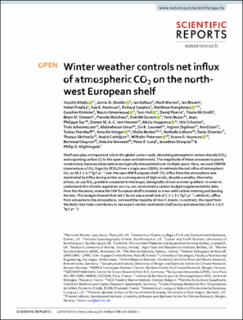Winter weather controls net influx of atmospheric CO2 on the north-west European shelf
| dc.contributor.author | Kitidis, Vassilis | |
| dc.contributor.author | Shutler, Jamie D. | |
| dc.contributor.author | Ashton, Ian | |
| dc.contributor.author | Warren, Mark | |
| dc.contributor.author | Brown, Ian | |
| dc.contributor.author | Findlay, Helen S. | |
| dc.contributor.author | Hartman, Sue E. | |
| dc.contributor.author | Sanders, Richard | |
| dc.contributor.author | Humphreys, Matthew P. | |
| dc.contributor.author | Kivimäe, Caroline | |
| dc.contributor.author | Greenwood, Naomi | |
| dc.contributor.author | Hull, Tom | |
| dc.contributor.author | Pearce, David A. | |
| dc.contributor.author | McGrath, Triona | |
| dc.contributor.author | Stewart, Brian A. | |
| dc.contributor.author | Walsham, Pamela | |
| dc.contributor.author | McGovern, Evin | |
| dc.contributor.author | Bozec, Yann | |
| dc.contributor.author | Gac, Jean-Philippe | |
| dc.contributor.author | Van Heuven, Steven M.A.C. | |
| dc.contributor.author | Hoppema, Mario | |
| dc.contributor.author | Schuster, Ute | |
| dc.contributor.author | Johannessen, Truls | |
| dc.contributor.author | Omar, Abdirahman | |
| dc.contributor.author | Lauvset, Siv Kari | |
| dc.contributor.author | Skjelvan, Ingunn | |
| dc.contributor.author | Olsen, Are | |
| dc.contributor.author | Steinhoff, Tobias | |
| dc.contributor.author | Körtzinger, Arne | |
| dc.contributor.author | Becker, Meike | |
| dc.contributor.author | Lefevre, Nathalie | |
| dc.contributor.author | Diverrès, Denis | |
| dc.contributor.author | Gkritzalis, Thanos | |
| dc.contributor.author | Cattrijsse, André | |
| dc.contributor.author | Petersen, Wilhelm | |
| dc.contributor.author | Voynova, Yoana G | |
| dc.contributor.author | Chapron, Bertrand | |
| dc.contributor.author | Grouazel, Antoine | |
| dc.contributor.author | Land, Peter E. | |
| dc.contributor.author | Sharples, Jonathan | |
| dc.contributor.author | Nightingale, Philip D. | |
| dc.date.accessioned | 2020-04-01T14:15:40Z | |
| dc.date.available | 2020-04-01T14:15:40Z | |
| dc.date.created | 2020-01-28T10:28:51Z | |
| dc.date.issued | 2019 | |
| dc.identifier.issn | 2045-2322 | |
| dc.identifier.uri | https://hdl.handle.net/11250/2649955 | |
| dc.description.abstract | Shelf seas play an important role in the global carbon cycle, absorbing atmospheric carbon dioxide (CO2) and exporting carbon (C) to the open ocean and sediments. The magnitude of these processes is poorly constrained, because observations are typically interpolated over multiple years. Here, we used 298500 observations of CO2 fugacity (fCO2) from a single year (2015), to estimate the net influx of atmospheric CO2 as 26.2 ± 4.7 Tg C yr−1 over the open NW European shelf. CO2 influx from the atmosphere was dominated by influx during winter as a consequence of high winds, despite a smaller, thermally-driven, air-sea fCO2 gradient compared to the larger, biologically-driven summer gradient. In order to understand this climate regulation service, we constructed a carbon-budget supplemented by data from the literature, where the NW European shelf is treated as a box with carbon entering and leaving the box. This budget showed that net C-burial was a small sink of 1.3 ± 3.1 Tg C yr−1, while CO2 efflux from estuaries to the atmosphere, removed the majority of river C-inputs. In contrast, the input from the Baltic Sea likely contributes to net export via the continental shelf pump and advection (34.4 ± 6.0 Tg C yr−1). | |
| dc.language.iso | eng | |
| dc.rights | CC BY 4.0 | |
| dc.rights.uri | https://creativecommons.org/licenses/by/4.0 | |
| dc.title | Winter weather controls net influx of atmospheric CO2 on the north-west European shelf | |
| dc.type | Peer reviewed | |
| dc.type | Journal article | |
| dc.description.version | publishedVersion | |
| cristin.ispublished | true | |
| cristin.fulltext | original | |
| cristin.qualitycode | 1 | |
| dc.identifier.doi | 10.1038/s41598-019-56363-5 | |
| dc.identifier.cristin | 1783784 | |
| dc.source.journal | Scientific Reports | |
| dc.source.volume | 9 |

